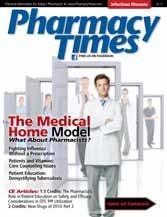Let's Not Treat Immunizations as a Commodity
The administration of immunizations can transform the community pharmacy into a community heath center.
The administration of immunizations can transform the community pharmacy into a community heath center.

All states now allow pharmacists to administer immunizations. This amazing accomplishment occurred over 2 decades and demonstrates how collaboration— rather than competition—can achieve important results. Administering immunizations in the community pharmacy, I believe, has helped position the pharmacy as a community health center, rather than just a place to get your prescription filled. This new role should also make it easier for us as we try to position the pharmacist as a primary care provider.
There is a recognized shortage of primary care providers, so using the pharmacist to help meet this need may be required to provide the services needed by patients. Pharmacist administration of flu vaccines during the recent H1N1 pandemic was recognized as critical to the success of that effort to immunize all citizens. Like North Carolina, many other state pharmacy associations are now pursuing legislation to allow pharmacists to administer all approved vaccines—and also to lower the age of eligible recipients to include younger individuals. In North Carolina, we are positioning this activity as a public health initiative, not a medical care program. Even so, we are seeing opposition to this expanded role from colleagues in other professions, especially medicine.
This opposition is occurring even as the Centers for Disease Control and Prevention (CDC) reports that adult immunization rates are far below what they should be. The CDC reports that only one third of eligible people 18 years or older got their flu shot last year. Immunization levels were even lower for many other vaccines. So, expanding the pharmacist immunization role would most likely increase overall immunization rates by focusing more attention on the need. The new health care reform legislation places an emphasis on prevention by trying to improve vaccination rates. Health care plans will be required to cover more vaccines. Thus, expanding who can administer vaccines to include pharmacists, and where vaccines may be administered to include community pharmacies, makes for good health policy.
Although I am excited by the opportunity to see an expanded immunization role for pharmacists, I am also concerned that if pharmacists and their employers are not careful, such an expanded role could cause problems. Let me share an e-mail I received from a North Carolina pharmacist:
“I recently left my job as the pharmacist in charge due to my belief that the public is being put at risk of harm by workload demands on the pharmacy, including the administration of immunizations. Understandably, there are few guidelines in place regarding pharmacy workload and safe practices regarding flu shots since this is a relatively ‘new’ service most retail pharmacies offer; however, I do believe ability to generate profit has disrupted the retail pharmacists’ ability to give immunizations safely. “My employer insisted we treat an immunization request like ‘any other prescription, “claiming it should not interrupt workflow since all the immunizing pharmacist has to do is ‘fill out the bottom of the consent form and administer the shot.’ My experience has been that this is the least an immunizer would have to do and bypasses several steps to ensure patient safety. “There are questions on the consent form which should be reviewed with each patient, and preparation of the immunization requires more attention than removing a pill from a bottle. Recently, they demanded I open availability to any time I was present. We were given no additional support staff or pharmacist coverage. I told my supervisor I was extremely uncomfortable with this demand because our workload simply did not permit time to pull away from filling prescriptions to administer immunizations. Likewise, interrupting workflow to give immunizations would result in even less time to fill and properly check prescriptions. As I tried to explain the position I was in and the potential risk I was being forced to take, he began to dismiss my concern for patient safety because my store ‘was not making budget.’ “I am still very upset by the preceding events. So much so that this is the reason I quit that day. I felt as long as this is the risk I was being forced to assume as a pharmacist I could no longer work there. Over the years, I know I have helped a lot of people and never consciously put them at risk of harm….My leaving that day may not have been the most ‘professional’ thing I have ever done, but it was the best thing I could have done for my patients and my profession as a pharmacist.”
Whether you or I would do what this pharmacist did, the individual acted in what he or she thought was the best interest of the patients. In a recent conversation, a colleague in a pharmacy chain was lamenting how many pharmacies are discounting the cost of a flu shot to secure more business. I use these 2 examples to express my concern that we not let the administration of an immunization become just another commodity that you buy at a pharmacy, rather than a preventive health encounter at a community health center, your neighborhood pharmacy. PT
Mr. Eckel is a professor at the Eshelman School of Pharmacy, University of North Carolina at Chapel Hill. He serves as executive director of the North Carolina Association of Pharmacists.

